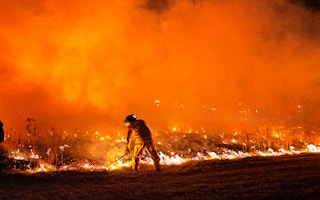The deadliest US wildfires in over a century have killed more than 100 people in Hawaii, destroyed or damaged more than 2,200 buildings and caused an estimated US$5.5 billion in losses, grabbing global headlines about the effects of climate change.
The Maui wildfire ravaged the resort town of Lahaina in August, charring a 5 square-mile (13 square-km) area in hours and burning so ferociously that even metal structures melted.
The Hawaii disaster came soon after wildfires drove tourists to flee their hotels in Greece and major cities were blanketed in smoke from blazes in Canada, where fires have engulfed parts of nearly all 13 provinces and territories this year.
Wildfires are increasing in frequency and severity across the world, found a May 2023 report by the Organisation for Economic Co-operation and Development (OECD), a group of 38 countries.
The duration of the fire weather season has lengthened by 27 per cent globally since 1979 and wildfires have become more frequent, OECD researchers said. In Australia, for example, wildfire frequency has doubled since 1980.
Here is what researchers have found out about wildfires worldwide:
How bad are forest fires today?
As wildfires become more common in many regions, the occurrence of extreme wildfires – in terms of their size, duration, intensity and impacts – is also on the rise, the OECD researchers said.
Wildfire severity, which considers the ecosystem impacts caused by a fire, rose eight-fold between 1985 and 2017 in the forests of the western United States - including in badly affected California, the research found.
It said unsustainable land-use practices such as forest clearing and drying out of peatlands for agricultural expansion, especially monoculture farming, have also affected natural ecosystems’ resilience to wildfires.
Forest fires now cause about 3 million more hectares of tree cover loss each year than they did in 2001, researchers at the University of Maryland and monitoring service Global Forest Watch (GFW) said last year.
These fires accounted for more than a quarter of all tree cover loss over the past two decades.
What causes wildfires and what are the lasting impacts?
Climate change is a major reason for the increase in fires, with extreme heatwaves five times more likely now than 150 years ago and expected to become even more frequent as the planet continues to warm.
Higher temperatures dry out forests and landscapes to create the ideal environment for larger, more frequent forest fires. This results in higher CO2 emissions, further exacerbating climate change and in turn contributing to more fires.
Climate change is estimated to have doubled the total forest area burned in the western United States between 1984 and 2015, the OECD report said.
The extreme fire weather that facilitated the devastating 2019/20 wildfires in Australia was estimated to be at least 30 per cent more likely because of climate change.
But in most cases, human activity such as agricultural expansion, power cables, camp fires or deliberate arson, is responsible for nearly 70 per cent of the total burned area globally, OECD researchers said.
Deforestation and the drainage of peatlands worsen drought conditions and increase landscape flammability - contributing to the occurrence of extreme wildfires in countries such as Brazil and Indonesia, the OECD report added.
Certain forestry practices also increase wildfire risk, as evidenced in 2017 in Portugal, where non-native eucalyptus provided highly flammable fuel.
Besides causing long-lasting and irreversible ecosystem damage, extreme wildfires can lead to hefty economic losses and harm human health.
Globally, wildfire-induced air pollution is associated with 340,000 premature deaths annually, the OECD report said.
The 2019/20 wildfires in Australia caused US$23 billion in direct costs, while the 2018 Camp Fire in California cost about US$19 billion, it added.
What can countries do to combat wildfire risks?
In the past two decades, at-risk countries have increased resources to suppress wildfires up to four-fold, but they have had limited success in containing damage.
Healthy ecosystems are more resilient and less prone to wildfire ignition and spread, so protecting and restoring degraded forests and peatlands has become a key element in many countries’ wildfire prevention efforts, the OECD said.
Limiting illegal and unsustainable land use, and the scaling up of monitoring and enforcement efforts, is also vital.
Better land-use planning and building rules and standards are key to protecting lives and assets, and play a key role in containing wildfire risk and impacts, the report said.
Up-to-date information on wildfire hazard, exposure and vulnerability can help to better assess future wildfire risk while also inform prevention and preparedness decisions.
Coordination, collaboration and the exchange of knowledge across sectors and levels of government also need to be strengthened, the OECD added.
But there is no solution for bringing fire frequency back down to historical levels without drastically cutting greenhouse gas emissions, GFW researchers said.
This story was published with permission from Thomson Reuters Foundation, the charitable arm of Thomson Reuters, that covers humanitarian news, climate change, resilience, women’s rights, trafficking and property rights. Visit https://www.context.news/.










